Germany is known for its rich, hearty, filling dishes and foods with high-quality, often locally sourced ingredients.
The cuisine of Germany has been shaped not only by the country’s regions and traditions but also by the immigrants who have made the country home over the centuries.
There are many different kinds of German food available. Germany is most famous for meat dishes; pork, poultry, and beef are the most common varieties.
German cuisine has many street food options, light side dishes, sweet desserts, and drinks. Also, it includes vegan, gluten-free, and other dietary preferences or restrictions.
As for desserts, Germans are masters of fruit desserts, especially desserts made from apples. Bakeries contain sweet treats, ranging from black forest cake to berry tarts.
So, whether you’re looking for traditional dishes or modern favorites, we’ve gathered the 30 best German foods in this blog.
Let’s explore each.
1. Bratwurst

Bratwurst is one of the most famous German foods, a sausage with a rich history dating back to the early Middle Ages. The term “Bratwurst” itself is derived from the Old High German word “Brätwurst,” where “brät” means finely chopped meat, typically pork, and “wurst” refers to sausage.
It is believed to have originated in the Franconian region of Germany, specifically from the city of Nuremberg. Nuremberg’s Bratwurst is one of the most famous variations, characterized by its small size (around 3-4 inches in length) and savory blend of pork, veal, and spices such as marjoram, nutmeg, and ginger.
Throughout Germany, various regions have their distinct styles of Bratwurst, each with unique flavors and ingredients. For example:
- Thuringia: The Thüringer Rostbratwurst is famous, featuring a coarser grind of pork seasoned with garlic, caraway, and sometimes mustard seed.
- Bavaria: The Weißwurst reigns supreme, a pale, finely ground sausage made with veal and pork back bacon, flavored with parsley, lemon, mace, onions, ginger, and cardamom
Bratwurst is a popular dish enjoyed in different ways across Germany. It’s commonly grilled or pan-fried until golden brown and served alongside accompaniments.
- It is traditionally served in sets of six or twelve, accompanied by sauerkraut, mustard, and freshly baked bread rolls.
- As a breakfast staple, it is often enjoyed with sweet mustard, pretzels, and a refreshing glass of wheat beer.
- Mostly grilled over an open flame and served with sauerkraut, mustard, and a side of potato salad.
- Bratwurst is served in sandwiches, pizzas, or even pasta dishes in modern German cuisine.
Whether enjoyed at a bustling beer garden or cooked at home with family and friends, Bratwurst holds a special place in German culinary tradition.
2. Sauerbraten
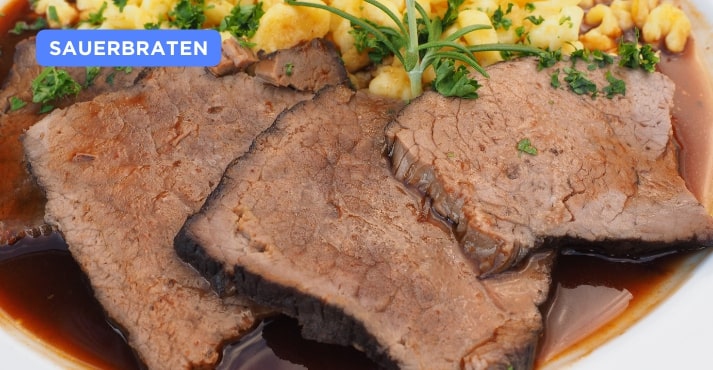
Sauerbraten is a German national dish, a classic pot roast known for its tender texture and tangy flavor. The preparation of Sauerbraten involves marinating beef, typically from the shoulder or rump, in a mixture of vinegar, water, onions, carrots, and a blend of spices such as cloves, peppercorns, and bay leaves.
The beef is richly marinated for a few days in this mixture, resulting in tender meat and a succulent dish. After marinating, the beef is typically browned and then slow-cooked in the marinade, allowing the flavors to blend and the meat to become fork-tender.
Sauerbraten is often served with traditional sides such as:
- Red cabbage
- Potato dumplings
- Spaetzle
The unique tanginess of Sauerbraten comes from the vinegar marinade, which balances beautifully with the richness of the beef and the aromatic spices. This beloved dish is cherished for its flavors and time-honored preparation methods.
3. Schnitzel
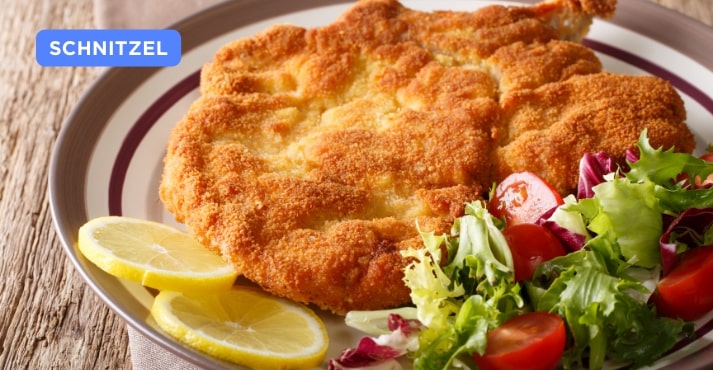
Schnitzel is another popular food in Germany, a dish consisting of thinly pounded meat, typically veal, pork, or chicken, that is coated in breadcrumbs and fried until golden and crispy.
The term “Schnitzel” comes from the German word “schnetz,” meaning slice or shred, referring to the thinly pounded nature of the meat.
Here’s a list of 10 different types of Schnitzels:
- Wiener Schnitzel
- Jaegerschnitzel
- Rahmschnitzel
- Zigeunerschnitzel
- Cordon Bleu Schnitzel
- Holsteiner Schnitzel
- Paprika Schnitzel
- Parmesan Schnitzel
- Schnitzel Wiener Art
- Schnitzel Milanese
Popular serving styles for schnitzels include:
- Jaegerschnitzel is topped with brown mushroom gravy.
- Zigeunerschnitzel is topped with a sauce made from tomatoes, bell peppers, and onions.
- Käseschnitzel is topped with different types of cheese.
- Rahmschnitzel is topped with a creamy sauce, often mushroom-based, but different from the brown gravy used for jaeger schnitzel.
Moreover, the breading of Schnitzel can vary from region to region and personal preference, with some recipes calling for a simple breadcrumb coating. In contrast, others may incorporate herbs or spices for added flavor.
Here are some of the most commonly used breading variations in German food:
- Traditional breadcrumb coating
- Panko breadcrumb coating
- Flour, egg wash, and breadcrumb coating
- Flour and breadcrumb mixture
- Cornmeal coating
- Potato chip or pretzel coating
- Almond or nut-coating
- Herbed breadcrumb coating
- Seasoned flour coating
- Cracker crumb coating
These variations showcase the versatility of Schnitzel in German cuisine, catering to a wide range of tastes and preferences.
4. Apfelstrudel

Apfelstrudel originated in Austria but was adopted by Germany in its local cuisine. It has a rich history dating back to the 17th century. Originating in the Habsburg Empire, it was influenced by Turkish baklava and became popular throughout the region.
The perfect flaky pastry is created by stretching the dough thin enough to read a newspaper through it. This process requires skill and patience to ensure a delicate, crisp texture.
Variations of Apfelstrudel may include different fillings such as:
- Classic Apfelstrudel (with apples, sugar, cinnamon, and breadcrumbs)
- Apfel-Nuss-Strudel (with apples and nuts)
- Apfel-Rosinen-Strudel (with apples and raisins)
- Apfel-Kartoffel-Strudel (with apples and potatoes)
- Apfel-Quark-Strudel (with apples and quark cheese)
- Apfel-Marzipan-Strudel (with apples and marzipan)
- Apfel-Vanille-Strudel (with apples and vanilla)
- Apfel-Zimt-Strudel (with apples and extra cinnamon)
- Apfel-Honig-Strudel (with apples and honey)
- Apfel-Kirsch-Strudel (with apples and cherries)
Once baked, it is dusted with powdered sugar and served warm with a whipped or vanilla ice cream dollop. Traditionally, Apfelstrudel is enjoyed as a dessert or sweet treat with coffee or tea, but it can also be served on special occasions or as part of a festive meal.
5. Black Forest Cake

The Black Forest cake has existed for over 100 years. Black Forest Cake, or Schwarzwälder Kirschtorte, originated in the Black Forest region of Germany. The colors of the cake match the traditional clothes people wore in the Black Forest.
Refrigerators weren’t standard back then, so cakes with cream weren’t famous until later. By 1949, the cake wasn’t very well-known, but it quickly became a favorite and even famous in Germany.
This dessert features layers of chocolate sponge cake soaked in Kirsch (cherry brandy), filled with whipped cream and cherries, and covered in more whipped cream, chocolate shavings, and maraschino cherries.
The critical ingredients of black forest cake are:
- Chocolate sponge cake
- Kirsch (cherry brandy)
- Whipped cream
- Cherries (typically sour cherries or cherry pie filling)
- Chocolate shavings or curls
- Maraschino cherries (for decoration)
Black Forest Cake holds significant cultural importance in German celebrations and is often served during special occasions such as birthdays, weddings, and holidays, symbolizing indulgence and tradition. Black Forest Cake isn’t just a dessert but a symbol of German culinary heritage.
6. Kartoffelsalat (Potato Salad)
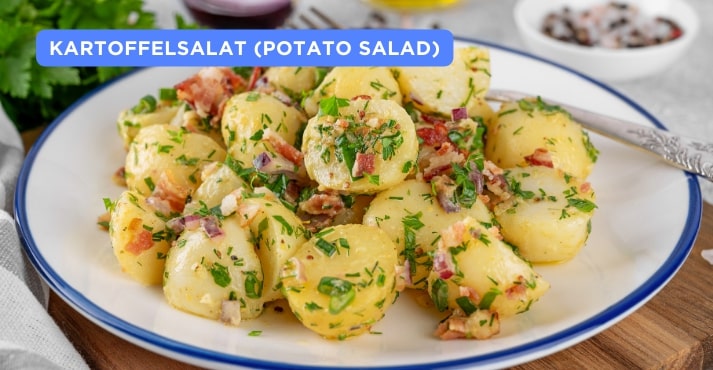
German Kartoffelsalat, or potato salad, is one of the most famous German dishes, with each area bringing its unique variation.
In southern Germany, like in Bavaria, potato salad is typically served warm with a tangy vinegar-based dressing, mixed with onions, mustard, and sometimes bacon or beef broth for added flavor.
Northern German potato salad, on the other hand, tends to be served cold with a creamy mayonnaise-based dressing, often accompanied by pickles, onions, and fresh herbs.
Ingredients for German potato salads vary widely based on regional preferences and family recipes but commonly include:
- Boiled potatoes
- Onions
- Vinegar or mayonnaise
- Mustard
- Salt and pepper
Some variations include bacon, pickles, apples, celery, or hard-boiled eggs for added texture and flavor complexity.
German potato salad is a staple side dish at gatherings, picnics, and celebrations. Its adaptability and rich flavors make it a beloved dish that reflects the diverse cuisine of Germany.
7. Kartoffelsuppe (Potato Soup)

Kartoffelsuppe, or Potato Soup, is a hearty and comforting dish important in German cuisine. It consists of potatoes simmered with onions, leeks, carrots, and sometimes celery in a flavorful broth, often enriched with cream or stock.
The soup is typically seasoned with herbs such as thyme, parsley, and bay leaves and may also include diced bacon or sausage for added flavor.
Potato Soup is cherished in Germany for several reasons, including
- Potatoes have been a staple crop in German agriculture for centuries.
- Kartoffelsuppe is a practical and economical dish that utilizes readily available ingredients.
- The Potato Soup recipe is passed down through generations in Germany.
Whether enjoyed as a quick weekday meal or served at festive gatherings, Potato Soup is cherished for its ability to comfort those who enjoy it. It can be enjoyed as a simple and satisfying meal or served alongside crusty bread or a sausage.
Moreover, particularly during cold winter, it is used to warm the body and soul with regional preferences and seasonal ingredients.
8. Kartoffelpuffer (Potato Pancakes)
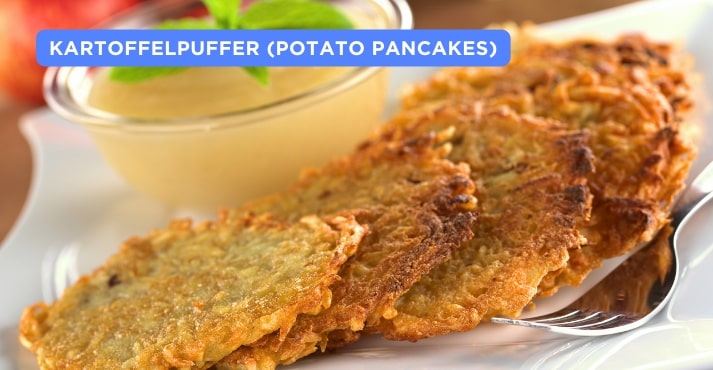
Kartoffelpuffer, or potato pancakes, is a crispy delight in German cuisine. Made from grated potatoes mixed with eggs, flour, and seasonings, then fried until golden brown, they offer a crunchy exterior and a tender interior.
It is served with applesauce, sour cream, or a sprinkling of sugar. Kartoffelpuffer is a snack or side dish cherished for its irresistible texture and flavor.
Kartoffelpuffer is also a famous German street food. With changing snack industry trends, consumers are looking for on-the-go snacking, and Kartoffelpuffers are served piping hot from street vendors.
Topped with a dollop of applesauce or a sprinkle of sugar, Kartoffelpuffer offers a satisfyingly savory-sweet flavor that delights locals and visitors alike.
9. Rotkohl (Red Cabbage)

Rotkohl translates as Red Cabbage. It is also known as Blaukraut or Blaukohl. Traditionally, it is prepared by shredding cabbage and cooking it with apples, onions, vinegar, sugar, and spices like cloves and bay leaves.
The slow simmering process infuses the cabbage with sweet and tangy flavors, resulting in a vibrant dish that pairs well with German meals, offering a delightful balance of savory and sweet.
Here are some of the most popular regional variations:
- Süßer Rotkohl: Sweet red cabbage, popular in southern Germany, is cooked with sugar, apples, and vinegar for a sweet and tangy flavor.
- Saurem Rotkohl: Sour red cabbage, ordinary in northern Germany, is prepared with vinegar and spices, offering a more tangy taste.
- Rotkohl mit Äpfeln: Red cabbage with apples, a variation found throughout Germany, combines the sweetness of apples with the tanginess of cabbage, creating a flavorful and balanced dish.
- Würziger Rotkohl: Spicy red cabbage, found in some regions, includes additional spices like cloves, cinnamon, and juniper berries for a more complex flavor profile.
German people prefer having Rotkohl for several reasons, such as its versatility to be enjoyed hot or cold, making it suitable for various occasions and seasons. Rotkohl’s nutritional benefits, including its high vitamin and fiber content, align with German dietary preferences for balanced meals.
However, Rotkohl brings nostalgic memories of family gatherings and festive celebrations, and its presence on the table symbolizes tradition, warmth, and hospitality.
10. Sauerkraut
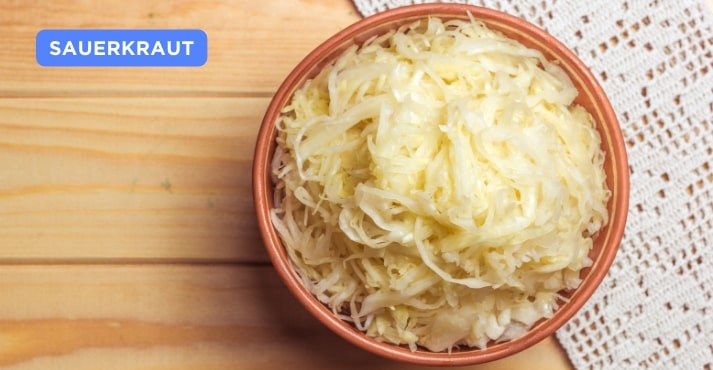
Sauerkraut is one of the best-known German food in Germany. Its origins lie in China, where fermented cabbage dishes were prepared as early as 220 B.C. as Chinese laborers built the Great Wall of China.
Sauerkraut is a cabbage that has been cured and fermented, although it doesn’t create alcohol but a lactic acid solution that is similar to vinegar.
Sauerkraut used in German dishes includes:
- It is served as a side dish, accompanying German sausages and pork dishes.
- It is a crucial ingredient in dishes like Sauerkraut Suppe (sauerkraut soup).
- It is used as a filling for traditional German dishes such as Sauerkrautknödel (sauerkraut dumplings).
- It can be mixed with potatoes and bacon to create a flavorful dish known as Sauerkraut und Kartoffeln (sauerkraut and potatoes).
- Sauerkraut is also added to the sandwiches, such as the famous Reuben sandwich.
Sauerkraut’s appeal goes beyond its delicious taste; it’s also a nutritional powerhouse consisting of probiotics, vitamins, fiber, antioxidants, and nutrient absorption qualities.
11. Pretzels
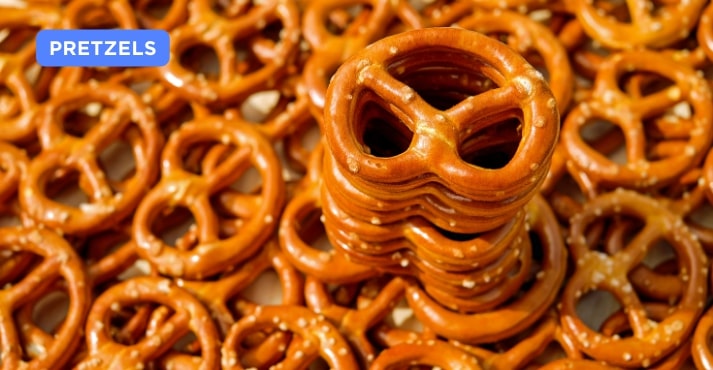
The history of the pretzel dates back to around the 6th century in Southern Germany. Created by monks, the pretzel’s distinctive shape symbolized arms crossed in prayer. Pretzels hold cultural significance in Germany, symbolizing luck, prosperity, and the bond of friendship when shared.
They have a crispy crust and soft interior, achieved through a unique alkaline bath before baking. Traditional flavors include salt, sesame, or poppy seeds, while modern variations may feature cheese or herbs.
They are a staple in German bakeries and beer gardens, enjoyed as a snack with mustard or cheese, celebrating the heritage of German baking.
12. Currywurst
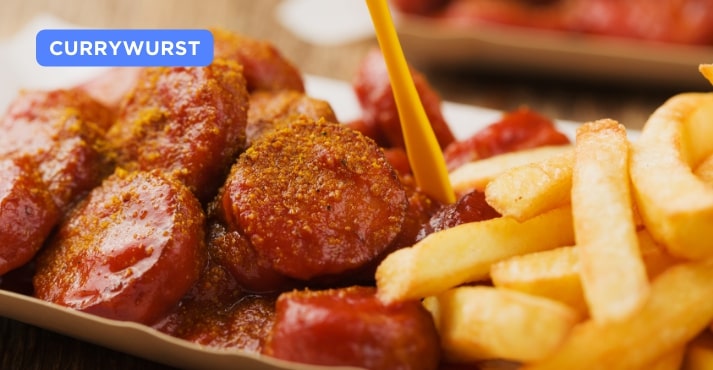
Currywurst is also one of Germany’s best foods, originating in post-war Berlin in the 1940s. A Berliner street food vendor concocted the dish by mixing ketchup and curry powder with Worcestershire sauce. She poured a tangy and slightly spicy sauce over sliced sausages, creating the iconic Currywurst.
It remains a staple of German street food culture, with countless variations nationwide. While the classic recipe features sliced pork or beef sausage smothered in curry ketchup, variations include different types of sausages, spicier sauces, and accompaniments like fries or bread rolls.
13. Matjes Herring

Matjes herring originated in the Netherlands during the Middle Ages. Its name means “maiden” in Dutch, referring to young herring. It’s preserved in salt and vinegar and is a cherished delicacy in Germany. Matjes is a traditional kind of herring eaten all year round.
It is enjoyed in regions like Schleswig-Holstein and along the North Sea coast. It is prepared by gently marinating young herring with salt, sugar, and vinegar.
In Germany, it is typically served and enjoyed with the following:
- Fresh with onions, apples, and dill
- Marinated in a mild brine
- Served on bread or toast
- Accompanied by boiled potatoes and sour cream
- Paired with pickles and dark bread
- Served alongside mustard and horseradish
- Enjoyed with a glass of beer or schnapps
Also, it is a nutritionally dense food that you can add to many recipes, as it has many nutrients that are hard to find in other foods, such as omega-3 fatty acids.
14. Lebkuchen
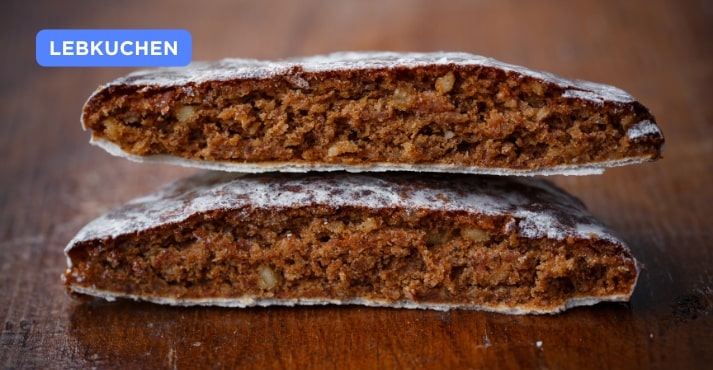
The lebkuchen is a cookie with a long and rich tradition. Lebkuchen translates to “gingerbread” in English and dates back to the 13th century. Traditionally, Lebkuchen was a dense, honey-based bread flavored with spices like ginger, cinnamon, and cloves.
Over time, it evolved into the sweet and spiced gingerbread we know today. Lebkuchen can be round, square, or rectangular. The cookies can be glazed or not glazed. It contains honey, nuts, and spices, bringing warmth and nostalgia.
Every region has its distinctive riffs on gingerbread. Lebkuchen gained popularity during Christmas markets and celebrations across Germany, becoming an iconic part of holiday traditions.
15. Bienenstich (Bee Sting Cake)

Bienenstich, or Bee Sting Cake, is a traditional German dessert with a rich and sweet flavor. The name “Bee Sting Cake” comes from the legend that bees were attracted to the sweet cake, giving it its distinctive name.
The history of Bienenstich, or Bee Sting Cake, can be traced back to the 15th century in the German region of Swabia.
It consists of a yeast dough base topped with a creamy vanilla custard or pudding filling and a layer of crunchy caramelized almonds. The topping consists of sliced almonds caramelized with honey and butter, creating a sweet and crunchy layer that adds depth and texture to the cake.
It can be easily found in virtually every bakery across Germany. Its deliciously indulgent yet comforting reputation makes it a favorite among locals and tourists. Today, Bienenstich is a beloved and iconic German dessert, enjoyed for its sweet honey-almond topping and rich flavor.
16. Eisbein
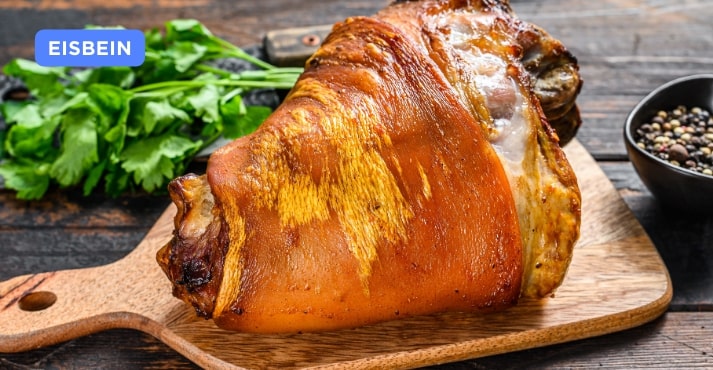
Eisbein is one of the most famous German national dishes. The Eisbein is commonly served with mashed potatoes or sauerkraut but can also be served with horseradish and mustard. It is often paired with a cold beer or a hearty red wine.
The preparation of Eisbein involves marinating a pork knuckle in a mixture of water, salt, sugar, and spices, such as bay leaves, peppercorns, and cloves. The knuckle is then slow-cooked by boiling or roasting until the meat is tender and the skin becomes crispy and golden brown.
Eisbein is special in German cuisine, often associated with hearty, festive meals and communal gatherings. It has historical roots as a dish enjoyed during celebrations and festivals, particularly in Bavaria and other regions of southern Germany.
17. Obatzda
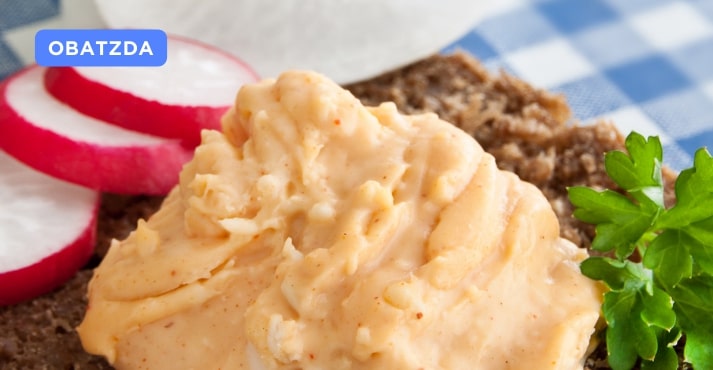
Obatzda, a Bavarian beer garden favorite, is a creamy and flavorful cheese spread with a distinctive taste. It has a rich and tangy flavor profile and is made from ripe Camembert or Brie cheese, butter, onions, paprika, and beer.
Obatzda originates in Bavaria, Germany, and is believed to have been created in the early 20th century, possibly in Bavaria’s beer gardens or traditional taverns. Its creation was likely inspired by the abundance of dairy products in the region, particularly soft cheeses like Camembert and Brie.
Over time, the recipe evolved with additional ingredients like garlic, caraway seeds, and horseradish. The spread is traditionally served with a pretzel or crusty bread, making it a perfect accompaniment to beer.
18. Apfelschorle (Apple Spritzer)
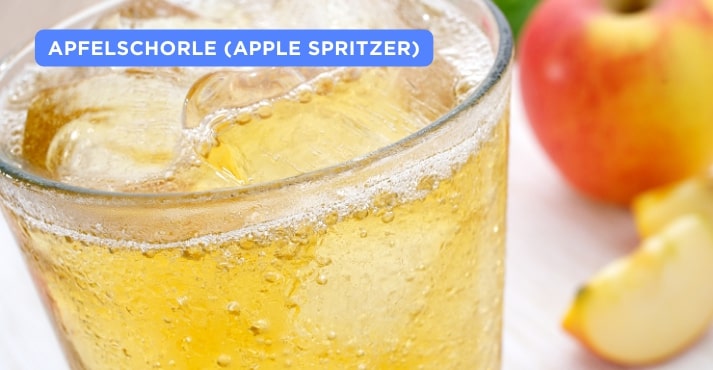
Apfelschorle, also known as Apfelsaftschorle, is German for apple spritzer or juice spritzer. For over a hundred years, Germans have been making and drinking an apple-based soft drink by diluting fruit juice with carbonated water.
Also, these apple spritzers are far less sweet and have fewer calories than just straight juice, making them a healthier alternative. Apfelschorle is cherished for its refreshing taste and thirst-quenching qualities, making it a favorite choice for hydration, especially during the hot summer months.
With different types of water with different amounts of carbonation available in Germany, the resulting drink can be modified to your taste.
19. Goulash
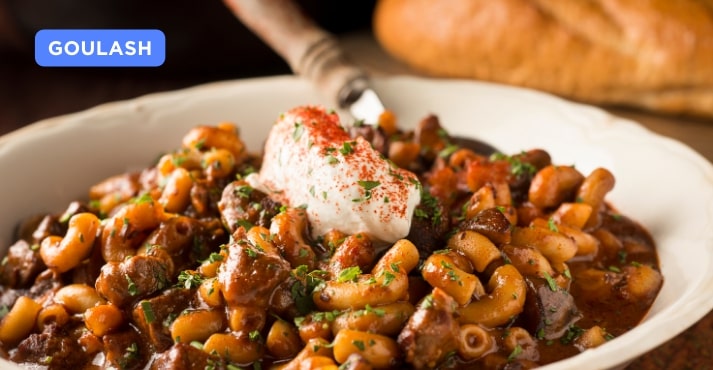
German Goulash is a flavorful stew that originated in Hungary but has become a popular dish in Germany. It typically consists of tender chunks of beef or pork, onions, bell peppers, and potatoes; all simmered in a rich and savory broth flavored with paprika and other spices.
Variations of German Goulash can be found across different regions, each adding its unique twist to the classic dish:
- Bavarian Goulash: Typically includes adding beer to the cooking liquid for added depth of flavor, along with ingredients like caraway seeds and juniper berries for a distinctive Bavarian taste.
- Swabian Goulash often adds spaetzle, a German egg noodle, to the stew, creating a heartier and more filling dish.
- Saxon Goulash: May add mustard to the sauce for a tangy kick and ingredients like marjoram and bay leaves for an aromatic flavor.
- Northern German Goulash: Tends to be lighter in flavor and may incorporate regional ingredients like apples or cabbage, adding a hint of sweetness or freshness to the stew.
Moreover, German Goulash is known for its comforting flavors, making it a favorite dish during colder months. It is often served with crusty bread, noodles, or rice and sometimes accompanied by a dollop of sour cream for added richness.
20. Rouladen
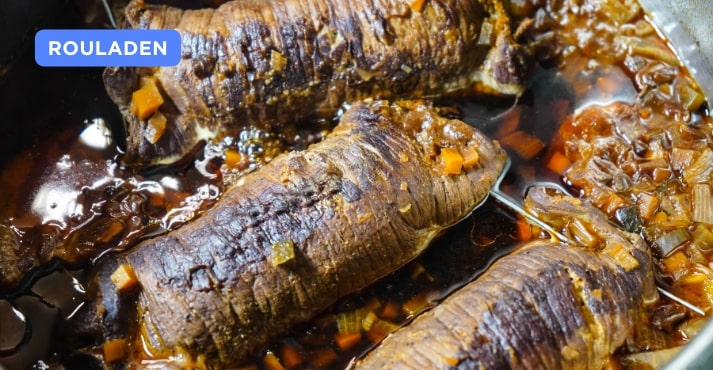
Rouladen is a German beef dish rolled up with bacon, onions, mustard, and pickles wrapped in thinly sliced beef or veal, then cooked.
The layers of Rouladen include
- Thin slices of beef or pork
- Mustard spread over the meat
- Bacon strips and onions placed on top
- Pickles or cucumbers added
- Rolled and secured with toothpicks or string
- Browned in a skillet
- Simmered in gravy or broth until tender
Stuffing for Rouladen typically consists of mustard spread over thin slices of beef or pork, topped with bacon strips, onions, and pickles or cucumbers.
Rolling techniques involve tightly rolling the meat around the stuffing ingredients, ensuring they are securely enclosed. Toothpicks or kitchen twine are often used to hold the rolls together during cooking, preventing the filling from escaping and holding their shape during the cooking process.
Rouladen is often served on celebratory occasions such as Christmas, Easter, and family gatherings. Its rich and flavorful profile makes it a favorite choice for holiday feasts, where it serves as a centerpiece dish alongside traditional sides like potato dumplings, red cabbage, and gravy.
The time-intensive preparation and flavors of Rouladen make it a symbol of celebration. A red wine gravy is an absolute requirement to round off the dish.
21. Königsberger Klopse
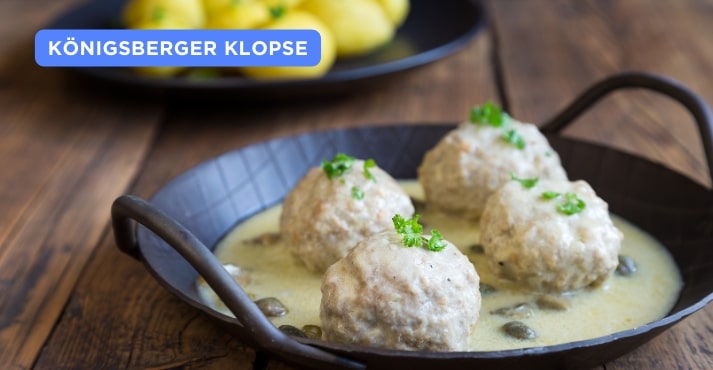
Germany has had a long tradition and history of cooking and eating meat. The German food industry has also redefined the trends in the meat sector, introducing different varieties of meats to the industry.
Königsberger Klopse, a classic dish from the Prussian city of Königsberg (now Kaliningrad, Russia), features tender meatballs made from a mixture of ground veal, pork, or beef mixed with onions, eggs, and breadcrumbs.
What sets these meatballs apart is the addition of anchovies, which impart a unique umami flavor. They are simmered in a flavorful broth until cooked through. The distinctive sauce, Kapernsauce, is made with a creamy base enriched with capers, lemon juice, and a touch of sour cream or cream.
Königsberger Klopse represents a clear but subtle monument to everything that Prussian regional cuisine finds comforting. In its modern form, this dish includes more meat, fewer extenders, and preserved fish servings.
Today, it is available under their traditional name in most German restaurants, but they are trendy in Berlin and Brandenburg.
22. Weisswurst
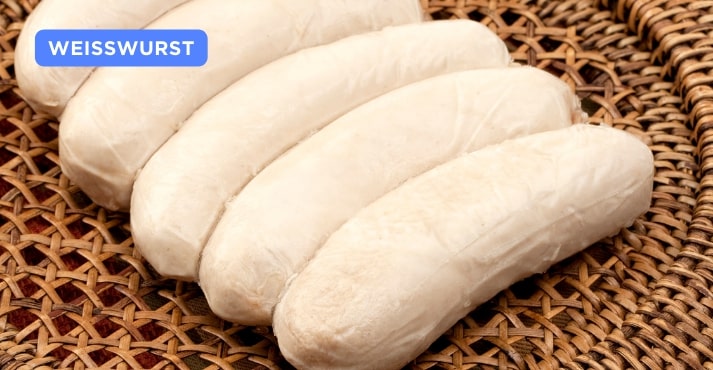
Weisswurst, translating to “white sausage” in English, is a traditional Bavarian sausage made from finely minced veal and pork bacon. It dates back to the early 19th century in Bavaria, Germany.
It was invented in Munich by butcher Johann Georg Seitz in 1857. Weisswurst quickly gained popularity as a breakfast sausage due to its mild flavor and delicate texture.
It is delicately seasoned with parsley, mace, lemon zest, onions, ginger, and cardamom, among other spices, giving it a mild and subtly aromatic flavor.
Unlike other sausages, Weisswurst is not smoked, resulting in its pale appearance. Traditional pairing options for Weisswurst include:
- Sweet mustard
- Pretzels
- Freshly baked bread
- Bavarian wheat beer
Weisswurst is a staple breakfast or snack item in Bavarian cuisine, enjoyed for its mild flavor and taste.
23. Maultaschen
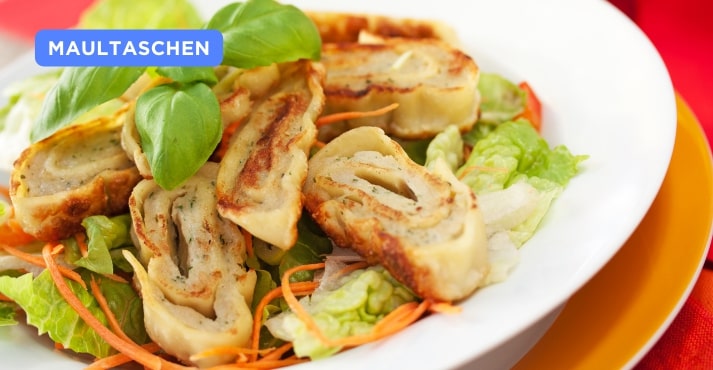
Maultaschen is especially popular in southern Germany. Maultaschen from Swabia, southwestern Germany, resembles oversized ravioli. In 2009, the European Union recognized Maultaschen as a regional specialty, acknowledging its significance to Baden-Württemberg’s cultural heritage.
These palm-sized, square pockets of dough boast a variety of fillings, from savory to sweet, including minced meat, bread crumbs, onions, and spinach seasoned with salt, pepper, and parsley.
Traditionally, they’re simmered in broth for a tender, creamy treat, though some prefer them pan-fried and buttered for extra richness.
Filled with a variety of ingredients, from savory minced meat to sweet spinach and onions, Maultaschen represents the culinary diversity and creativity of the region.
24. Himmel und Erde (Heaven and Earth)
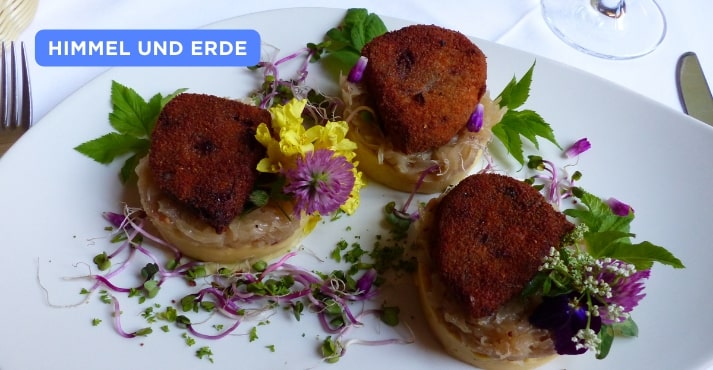
Himmel und Erde is one of the best German foods, translating to “Heaven and Earth” in English, and is a traditional German dish originating from the Rhineland region. It has been around since the 18th century and these days is a beloved staple of the many Kölsch breweries and beer halls.
It features unique ingredients, including mashed potatoes (representing the earth) and applesauce or stewed apples (symbolizing the heavens).
Also, fried onions and bacon are often added to enhance flavor and texture. To prepare, mashed potatoes are served alongside a generous portion of applesauce or stewed apples, topped with crispy fried onions and bacon pieces.
Himmel und Erde is a German regional dish, and each region may have its way of making it, but it’s loved everywhere in Germany for its unique taste and comforting qualities.
25. Birnen, Bohnen, und Speck (Pears, Beans, and Bacon)
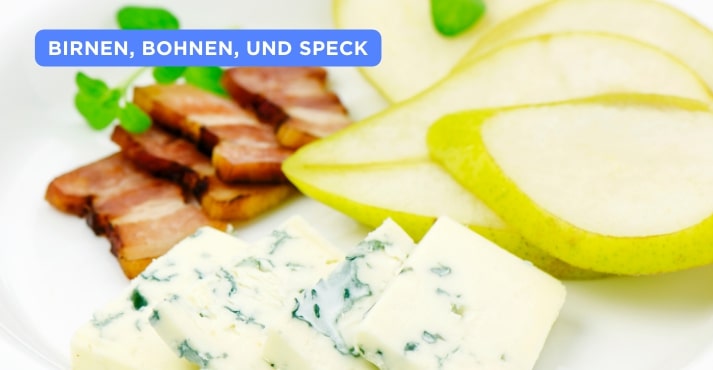
Birnen, Bohnen, und Speck, or Pears, Beans, and Bacon, is a traditional dish from northern Germany, particularly popular in Lower Saxony. It consists of green beans and diced bacon cooked together until tender, then served with poached or stewed pears.
Combining savory bacon, fresh green beans, and sweet pears creates a unique and flavorful dish that is enjoyed for its simplicity and taste.
While the essential components remain consistent across regions, there are variations in preparation methods and additional ingredients. Some variations include adding onions or potatoes, while others may add different spices or herbs, reflecting local tastes and culinary traditions.
26. Kaiserschmarrn
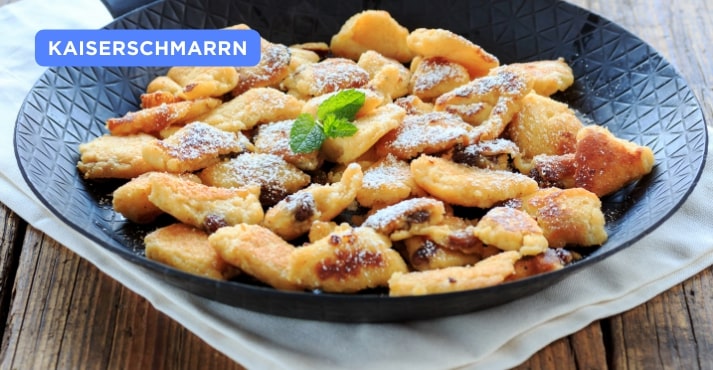
Kaiserschmarrn has a rich history and cultural significance in Germany and neighboring countries. This German dessert has gained popularity over the years.
It is a light and fluffy pancake dish made from a simple batter of flour, eggs, milk, and sugar. The batter is cooked in a pan until golden brown on both sides, then torn into small pieces with a spatula. The torn pancake is then caramelized in butter and sprinkled with powdered sugar.
Traditionally, raisins are added to the batter for extra flavor. It is often served with fruit compote, applesauce, or plum preserves, making it a delightful treat for breakfast, dessert, or a comforting snack.
27. Schupfnudeln

Schupfnudeln is one of the best German foods, similar to Italian gnocchi, made from mashed potatoes, flour, and sometimes eggs. These elongated, finger-shaped dumplings are rolled by hand and then boiled or pan-fried until golden brown.
They can be served as a savory dish with sauerkraut, bacon, or cheese or enjoyed sweet with cinnamon sugar or fruit compote. Schupfnudeln is a versatile comfort food in German cuisine.
Schupfnudeln comes in various unique shapes and flavors, including
- Traditional elongated finger shapes
- Rolled or twisted shapes
- Flavors such as plain potato, spinach, pumpkin, or cheese-infused varieties
- Sweet versions coated in cinnamon sugar or served with fruit compote
- Savory options accompanied by sauerkraut, bacon, onions, or cheese
Schupfnudeln are widespread across various regions of Germany but are particularly associated with southern German cuisine. Some regions where Schupfnudeln is commonly enjoyed include Bavaria, Swabia, and Baden-Württemberg.
28. Zwiebelkuchen
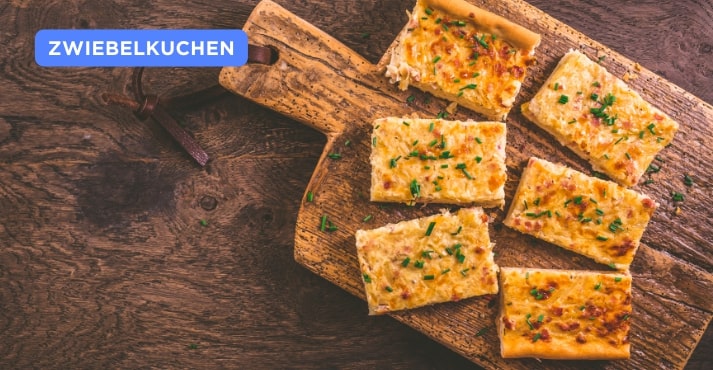
Zwiebelkuchen, translated as “onion cake,” is a savory delight in German cuisine, particularly popular in regions like Swabia and Franconia. It consists of a yeast dough base topped with caramelized onions, bacon, eggs, cream, and sometimes cheese and herbs.
The result is a rich, savory tart with a golden crust and a flavorful filling, often enjoyed as a snack or light meal alongside a glass of new wine (Federweißer) during the autumn harvest season.
Zwiebelkuchen is a traditional German pie primarily known in the wine regions and is usually eaten during the grape harvest. With changing beer industry trends, it is preferably eaten together with some of the most famous wines of Germany.
29. Metzgete
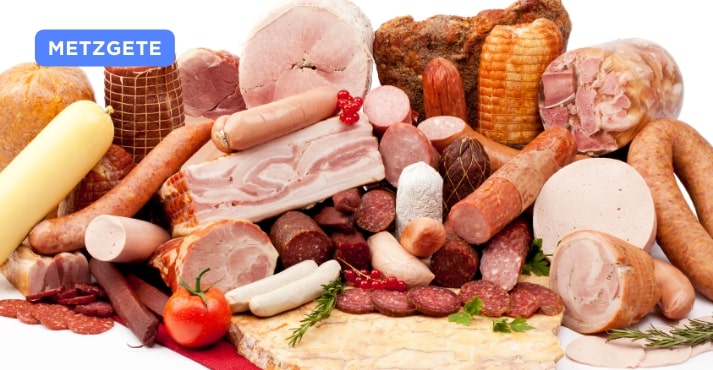
Metzgete, a traditional Swiss and southern German event, translates to “butcher’s feast” in English. It’s a culinary celebration typically held in autumn, where freshly butchered meats, particularly pork, are showcased in a feast.
Historically, autumn was the time when farmers would slaughter their livestock to preserve meat for the winter months when fresh food was scarce.
Metzgete features a variety of pork-based dishes such as sausages, blood and liver sausages, pork belly, and other offal. It’s a festive occasion where locals gather to enjoy hearty, rustic dishes and celebrate the harvest season.
Here are some of the most common dishes involved in Metzgete:
- Blutwurst: Blood sausage made from pork blood, fat, and fillers, typically seasoned with spices and herbs.
- Leberwurst: Liver sausage made from pork liver, fat, and seasonings, often spread on bread or served as a cold cut.
- Bratwurst: Grilled or fried pork sausage seasoned with spices like nutmeg, marjoram, and pepper.
- Schweinsbraten: Roast pork, often seasoned with garlic, caraway, and mustard, and slow-cooked until tender.
- Prestack: A pork sausage made from meat, jelly, and spices, pressed into a loaf and sliced for serving.
- Eisbein: Pork knuckle, typically boiled or roasted until tender and served with mustard or horseradish.
- Schlachtplatte: A platter featuring meats from the butcher’s slaughter, including sausages, cured meats, and offal.
Many traditional Metzgete dishes, such as sausages, roast pork, and potato salad, remain popular in modern German restaurants and households.
30. Rote Grütze
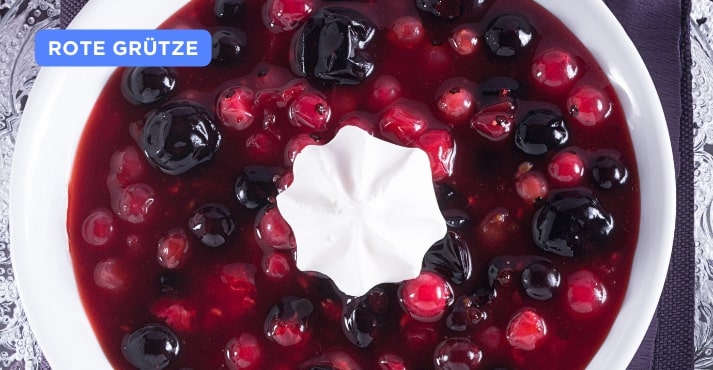
Rote Grütze traces its origins to northern Germany and Scandinavia. Originally a simple porridge made from berries and grains, it evolved into a popular dessert over centuries.
Rote Grütze is a traditional German dessert consisting of a compote or pudding made from various red fruits, typically strawberries, raspberries, and cherries, thickened with starch or tapioca.
Rote Grütze typically includes:
- Red fruits such as strawberries, raspberries, and cherries
- Sugar
- Water
- Thickening agents like cornstarch or tapioca
The people in Germany love Rote Grütze for its refreshing and summery qualities. Its vibrant colors and tangy-sweet flavor make it a delightful treat, often served chilled with whipped cream or vanilla sauce, especially during warm weather or festive occasions.
Conclusion
German cuisine is a delightful fusion of hearty flavors and traditional recipes. German foods offer diverse dishes, including popular dishes, regional specialties, and the cultural significance of food in Germany.
From iconic street foods like Currywurst to refreshing beverages like Apfelschorle, these best German foods tell a story of Germany’s diverse cultural heritage and regional influences.
The hearty and comforting flavors of classics like Schnitzel, Sauerkraut, and Sauerbraten give a sense of home and tradition. At the same time, innovative dishes like Lebkuchen showcase the country’s knack for combining sweet and spiced flavors.
Therefore, as a food manufacturer, you can add popular German foods into your product line and attract a broader consumer base. Moreover, recognizing the potential for scalability, food manufacturers at food exhibitions can provide deep insight into the cultural history of this region.












